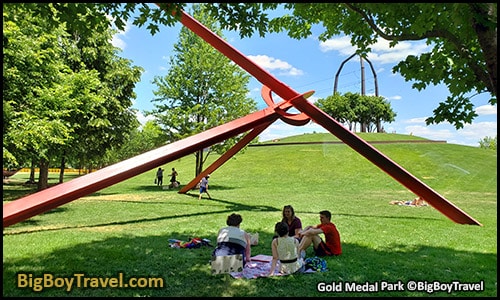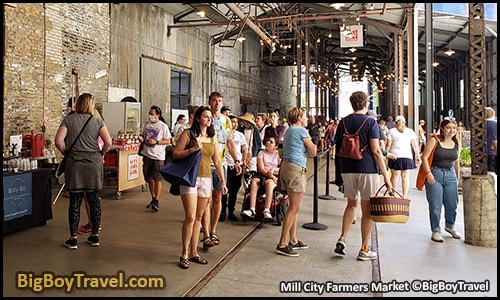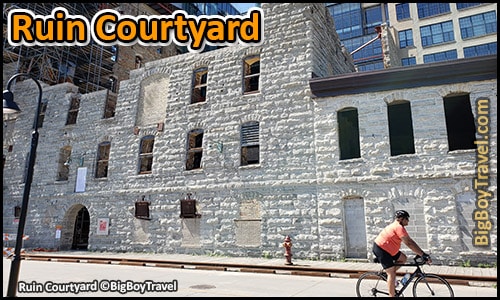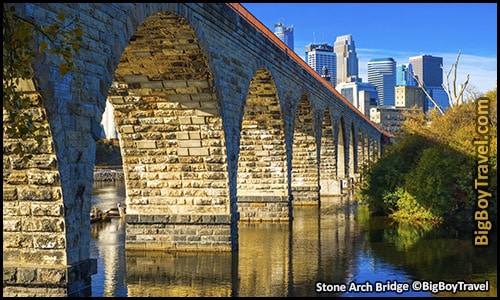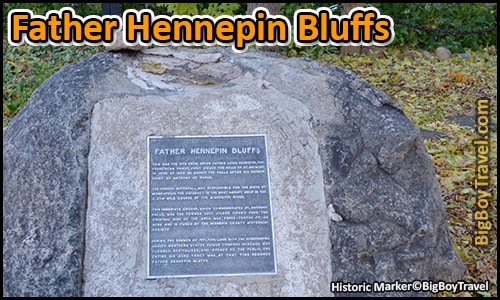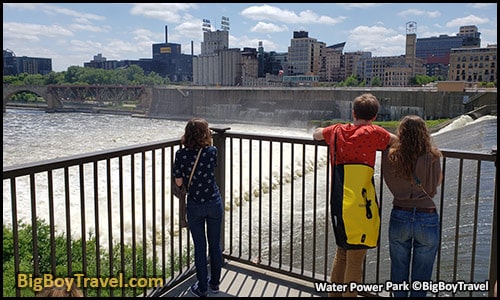Minneapolis Riverfront Walking Tour:
Location: Warehouse & Mill District Minneapolis
Cost: Free, Self-Guided (Optional Fees Listed Below)
Start: U.S. Bank Stadium Light Rail Stop
Stop: Government Plaza Light Rail Stop
Walking Distance: 3 Miles for the full loop
Time: Full loop takes 4.5 Hours with stops (1 Hour of Walking)
With A Car: 3 Miles for the full loop
Fun Scale: 9 out of 10
Riverfront & Mill District Overview:
Without the Riverfront and Mill District, there would be no Minneapolis and it is all centered on the Mississippi River’s only true waterfall. The falls, which were once over 180 feet tall, served as a meeting point for local Native American tribes for 100s of years leading up to the missionary Louis Hennepin’s visit in 1680. Heppepin was the first to write about the falls, re-named them after his favorite saint, and inspired visits from future explorers.
Formal settlement of the area began in the early-1800s after a negotiated relocation of the Native groups. Saint Anthony Falls (Owamenah) was quickly used to power many sawmills and the village of Saint Anthony was formed on the northside of the Mississippi River. Shortly after, settlement across the river started in Minneapolis which led the nation in lumber production through 1910. The two communities combined into a single milling powerhouse in 1872 that led the world in flour production with the formation of many long-lasting brands from General Mills to Philsberry.
Although most of the mills are gone and the waterfall is a shell of its old self, there are tons of historic remnants left over that make a walking tour through the River District a worthwhile experience. We hope you enjoy our Minneapolis Riverfront & Mill District walking tour!
Riverfront Walking Tour Sights:
1. Gold Medal Park:
About Gold Medal Park: As our Minneapolis Riverfront walking tour will bring you through a mix of nature and historic sites, it is only fitting to begin at the fabulous Gold Medal Park which blends both elements together. In the early days of the city, it was a milling town feeding its power off of the Mississippi River which included companies like Pillsbury and General Mills. It was the most famous product of General Mills, Gold Medal Flour, which gave the 7.5-acre park its name when it opened in 2007.
Over the park’s first decade, became home to 300 mature linden and maple trees that have been gracefully added in as natural borders and art-like accents. The trees here provide one of the most brilliant displays of Fall colors in Minneapolis. There is even a cluster of trees at the top of the centrally located 32-foot-tall earthen mound at the center of the Gold Medal Park. The mound pays homage to a series of sacred burial grounds in the area built over centuries by the Twin Cities’original Native inhabitants. Over 2,000 years there have been over eight tribal groups that called the Twin Cities home and some of the ancient burial mounds have lucky been preserved in Saint Paul (Indian Mounds Park) and in other parts of Minnesota including Green Lake.
Around the edges of the park, you will find a number of large outdoor art installations. If you have followed out Loring Park walking tour in past years, you may recognize some of the pieces as they were all donated from the Walker Art Center’s Sculpture Garden. The Walker’s garden, which is famous for its Spoon Bridge, was modernized with many new pieces from 2015-2017 which led to some of the iconic works being preserved here. We especially love the huge piece called Molecule which is made up of three gigantic red-coated iron beams. The addition of the artwork to Gold Medal Park mixed with the foliage and the peaceful mound help to make the area a place of reflection and reverence which has allowed it to become a fitting home to free yoga class on many Saturday mornings in the Fall.
On a somber note, the north side of the park has a memorial for the victims of the I-35 Bridge collapse that happened in 2007. The horrific collapse dropped 111 vehicles up to 115 feet with some landing in the Mississippi River. In total 13 people were killed and 145 more were injured in the event. As the nearby collapse happened on August 1st, just 3 months after Gold Medal Park opened, it became a gathering place for locals during the tragedy.
2. Guthrie Theater (818 South 2nd Street):
About The Guthrie Theater: Minneapolis is surprisingly one of the top 5 performance theater cities in the entire country and the futuristic-looking Guthrie Theater is possibly the most impressive venue. That is saying a lot, a Minneapolis is loaded with iconic theaters filled with opulent interiors dating back to the vaudeville era.
The first rendition of the Guthrie Theater was attached to the Walker Art Center in 1963 and was called “a miracle” by LIFE magazine. The entire concept was to further decentralize the theater from New York City and Minneapolis was selected over six other metropolitans. Actors were hired in a residency fashion versus touring to perform the classics (largely Shakesphere) in rotating repertory with a more immersive viewing experience starting with Hamlet. The concept was largely a success especially with the addition of A Christmas Carol and in 1982 the Guthrie Theater won a Ton Award for “outstanding contribution to the American theater”.
In 2006, the Guthrie Theater expanded to its today’s gigantic 285,000-square-foot modern complex housing three theaters under a gleaming, metallic blue exterior along the Minneapolis Riverfront. The most significant feature of the new Guthrie Theater is perhaps the 4th floor Endless Bridge which juts out 178 feet from the side of the building. The 30-foot wide bridge and outdoor terrace give great panoramic views over the Mississippi River below as you almost hang above it.
Maybe, even better than the bridge is the Pohlad Lobby next to Dowling Studio on the 9th floor which has floor-to-ceiling windows giving you amazing wrap-around views of the river and Minneapolis skyline. The huge 15-foot-tall windows are tinted a yellowish amber color giving the room a unique atmosphere and a section of the floor made out of plexiglass so you can peek 9 floors below. Even if you can’t make a show as the Guthrie, at least pop up to the Dowling Studio Lobby to take in the experience and views. You’ll be able to see the Minneapolis skyline, the Mississippi River, and the neighboring Gold Medal Park.
As a bit of trivia, it is cool to know that Emmy winner Sterling K. Brown was once a cast member at the Guthrie as a grad student in 2000 as was his wife Ryan Michelle. Sterling later returned to the Guthrie in 2018 for a special run and it highlights how the Guthrie has been able to recruit high-end talent with close connections to college drama programs. Other well known Guthrie alumni include Academy Award and Golden Globe winner Mahershala Ali (Moonlight), Golden Globe nominee Corey Stoll (House of Cards & Ant-Man), Morena Baccarin (Deadpool), Josh Radnor (How I Met Your Mother), Emily Swallow (The Mentalist), Dion Flynn (The Tonight Show), Cassandra Freeman (Single Ladies), and Miriam Hyman (Blue Bloods).
General Visiting Hours: Tuesday-Thursday 11am-8pm, Friday-Sunday 9am-8pm, Closed Mondays. Any day there is a theater performance the building stays open until 11pm and for Monday performances its opens from 2-11pm. Costume Tours: Tours of the Theater’s storehouse of 30,000 costumes are available on the 1st Saturday of each month. Backstage Tours: At 10am Friday and Saturday mornings they have $12 guided tours of the backstage workings of the Theater which last around 45 minutes. Theater Website: HERE.
3. Mill City Saturday Farmers Market (702 South 2nd Street):
About The Mill City Saturday Farmers Market: Located inside a historic yard rail for Minneapolis’ former flour mills, one of the best farmers markets in the Twin Cities has been setting up shop each Saturday since the Guthrie opened next door in 2006. This market not only has a great vibe but also has a great selection of fruits, vegetables, and flowers from the best local growers which has made it very popular. Because the farmers market is able to spill into a covered area of the adjoined Mill City Museum, it is open rain or shine in summer and even every other Saturday in the winter months.
We love how the weathered elements from the original rail yard are infused into the corridor housing the Mill City Farmers Market. As you shop you will see over 100-year-old exposed brick walls and rust-tinted iron beams under a canopy of glass, but you’ll have to look down for the hidden gem. Running the entire length of the market are the old railroad tracks which originally guided train cars into the Washburn A Mill and now serve to direct the foot traffic of eager Saturday shoppers.
Spring-Fall Hours: May through October; Every Saturday 8am-1pm. Winter Hours: November through April the farmers market moves inside the Mill City Museum; Every 2nd Saturday 10am-1pm. Market Website: HERE.
4. Mill City Museum (702 South 2nd Street):
About The Mill City Museum: From 1848 to 1888 the Mississippi River-powered Minneapolis led the World in sawmill production, but then the city quickly had a dramatic shift into the world of flour milling. Instead of being limited to floating logs down the river to their mills, new railroad lines allowed millers to reach an almost unlimited amount of grain for processing. Making the transition to flour even better was when a new process of separated hard spring wheat into flour revolutionizes the flour mill industry in 1870. Minneapolis was on the front lines of everything flour and quickly led the World in production with over 12 million loaves of bread a day.
Leading the way into the grain revolution were the Pillsbury and Washburn (now called General Mills) Companies. Both companies had operations on the Northside of the River, but Washburn quickly expanded to the Southside with their huge Washburn A Mill. Shortly after opening, the Washburn A Mill was the site of a horrible disaster on May 2nd, 1878 when flour dust exploded killing 12 workers and ruining nearby buildings. Within 2 years the mill was rebuilt in state-of-the-art fashion to be the highest producing mill in the World pushing Minneapolis to lead the World in flour until 1930.
The Washburn Mill’s biggest break in the flour industry probably came at the first International Millers’ Exhibition they attended in 1880 in Cincinnati, Ohio. The company had just perfected their flour which they entered as the exhibition where they won the gold, silver, and bronze medals. This victory truly established their company with worldwide exposure and their Gold Medal flour is still the #1 flour in the United States. The company continued to consolidate with other mills and became the Minnesota Milling Company. In 1928, the Minnesota Milling Company joined with 28 other mills to form General Mills which is still one of the biggest grain companies in the World.
The Washburn A Mill was finally shut down in 1965 after 85 years of service because it had become obsolete. The vacant 8 story building and its surrounding tunnels quickly became the home to dozens of homeless people and a huge fire in 1991 burned down every but the shell you see today. Since 2003 the ruins of the Washburn A Mill have served as the Mill City Museum. A tour will bring you up close and personal with the history of Minnesota as well as hands-on with tools from the mill era. You will visit the Baking Center, take an 8 story elevator up the Flour Tower with great River views, and you’ll watch the popular video Minneapolis in 19 Minutes Flat
Visiting Hours: Tuesday-Saturday 10am-5pm, Sunday Noon-5pm. Only open on Mondays during July & August from 10am-5pm, closed Mondays the rest of the year. Tour Schedule: The museum itself is free-roaming with trips up the Flour Tower leaving every 30 minutes. Cost: Public galleries and the outdoor ruins themselves are free. To tour the museum are and take the Flour Tower Elevator it’s $11 for Adults and $6 for Kids. Museum Website: HERE.
5. Mill City Courtyard & Boardwalk (702 West River Parkway):
About The Ruin Courtyard: On the Mississippi-facing side of the Mill City Museum is what many consider the most fascinating stop on our Riverfront walking tour, the Ruin Courtyard.
6. Mill Ruins Park (102 Portland Ave South):
About The Mill Ruins Park: Resembling an ancient Roman ruin in the heart of Minneapolis, the Mill Ruins Park opened in 2001 as a great homage to the industrial roots of the City. The mill ruins making up the park ended up being completely buried under feet of sand and gravel in the early 1900s and remain entombed until the 1980s when excavations began. Mill Ruin Park can easily be seen from the Stone Arch Bridge above but is best experienced with you path the path right into them.
As you explore the ruins notice the main water power canal which was built in 1857 to draw power from the Mississippi River’s strong flow. The mill building quickly followed the power canal being built from 1859 through the 1890s. The first mills were made for sawmilling before transitioning into flour milling. The success of the mills not only made Minneapolis the biggest milling city in the country but also lead to the formation of famous companies like General Mills, Pillsbury, Washburn Crosby (WCCO), and Northern States Power (Xcel Energy).
Ruins Park Hours: 6am-Midnight in developed areas; 6am-10pm in undeveloped areas. Cost: Free. Ruins Park Website: HERE.
7. Saint Anthony Falls (204 SE Main Street):
About Saint Anthony Falls: Serving as the lifeblood for early day Minneapolis, Saint Anthony Falls is the only true waterfall on the entire length of the Mississippi River (Hahawakpa: “river of the falls”). Known as Owamenah in the Dakota Language, these falls were once largest waterfalls in North America when it was carved out by a retreating glacier in 10,000BC.
At the waterfall’s original location (present-day Saint Paul) they were almost 200 feet tall and over half of a mile wide. That is larger than Niagara Falls! Over the millennium the falls have eroded upstream and gradually lost size along the way. As the falls worked their way toward present-day Minneapolis, they became a natural place of portage and a meeting point for trading between the Dakota and Anishinaabe Native groups. To aid in the visualization of some of the displays, we added some light blue lines to this Riverfront walking tour map so you can see how the location of the falls has changed over the centuries due to erosion.
Once development started on mills (1838-48) and dams (1856), the falls rate of receding sped up to 26 feet per year from the natural 4 feet per year. The first damn mainly generated power by creating a series of tunnels where the water would speed up to move each mill’s waterwheel. Finally, in 1869 St Anothony Falls ran out of limestone riverbed to carve away in a steering fashion and it collapsed into much smaller rapids taking the original damns with it. It was a large disaster in its day since the surrounding area was so dependent on the power. To quickly fix the problem they made a V-shaped apron, now made out of concrete, to funnel the smaller rapids and harness its remaining power. The nation’s 3rd hydroelectric plant was added in 1882 and finally, in 1950 the first locks are built to let large boats navigated further up the river.
Photos: (Falls Circa 1680 | Falls In 1860 | Close Up Of Falls In 1860 | Falls In 1865 | The Falls Today).
8. Stone Arch Bridge (100 Portland Ave South):
About The Stone Arch Bridge: One of the biggest limitations of the early mills in Minneapolis was how fast they could get in fresh wheat for flour since they were located on the Southern bank of the Mississippi River. Capitalizing on the issue, James J. Hill had his Minneapolis Union Railway Company build the Stone Arch Bridge to help bring in wheat from the Red River Valley and Canada.
James J. Hill, a railroad baron from Saint Paul, was considered America’s Empire Builder for his railroad lines extending from the Midwest all the way to the Pacific Ocean. When Hill’s 23 arch granite and limestone bridge opened in 1883, it quickly helped the Mills on the Minneapolis side of the Mississippi River compete and grow into the World’s biggest. The bridge put the Minneapolis bridges on the map by reducing travel time from Saint Paul to just 20 minutes as the trains could go full steam the entire way even over the well-designed bridge.
Long after the Mills faded in the mid-1900s, the Stone Arch Bridge continued to thrive with trains through 1965 when it eventually closed to rail traffic. After decades as a car bridge, Stone Arch was wisely renovated into a pedestrian-only bridge in 1994. Today the Bridge remains the only stone arch bridge on the entire Mississippi River and has become a focal point of the Stone Arch Bridge Festival (website) each June. If you wish to learn about James J Hill and his influence on the Twin Cities, make sure to visit his huge mansion which is the highlight of our popular Summit Avenue Walking Tour in Saint Paul.
As you cross the Stone Arch Bridge make sure to get a good view of St Anthony’s Falls (explained later) and the Army Corps of Engineers lock and dam near the start of the bridge. The locks are the uppermost of 29 locks connecting the Mississippi River with the Gulf of Mexico. The locks help boats navigate rapids and are able to change elevation in sections of the river by lowering or raising the water inside them like a liquid elevator.
9. Father Hennepin’s Bluff (10 6th Ave Southeast):
About Father Hennepin Bluffs: As you reach the northern end of the Stone Arch Bridge, you come to Lucy Wilder Morris Park which has a large stone marking the spot of Father Hennepin Bluffs. In the year 1680, Belgian explorer Father Louis Hennepin was being shown to a nearby village by local Dakota Indians when they went past a large sacred waterfall called Owamenah (falling water). With his view from this area, Hennepin became the first White person to see the falls, although had already been a trading, meeting, and portage point for Native groups for 100s of years.
Father Hennepin, who was a Franciscan Monk, wrote back east about the amazing falls which he took the liberty to rename the falls after Anthony of Pauda, his favorite saint. Over the next century, many other explorers were inspired to visit from Hennepin’s account and by the mid-1800s permanent settlers arrived establishing the cities of Saint Anthony (North/East side of Mississippi) and eventually Minneapolis (South/West side of Mississippi). Coincidentally, Hennepin was also the first explorer to write about Niagara Falls in New York State.
It is important to note that at the time Father Hennepin arrived in 1680 the falls were located much closer to today’s 35W bridge. Over time the falls continued to migrate upstream from erosion until the current location was settled with engineering in 1887. It wasn’t actually until around 100 years after Hennepin’s visit that the falls had worked to be even to the spot of the historic marker so do not take the location as exact.
Just beyond the maker for Father Hennepin’s Bluff sits the Southeast Steam Plant which has been open since 1903. The plant was built to power Minneapolis’ streetcar system which helped the Twin Cities have one of the most extensive transit systems in the United States during the early 1900s. Even after the last of the streetcars were converted to buses in 1954, the Southeast Steam Plant remained open to provide steam heating for the University of Minnesota’s boiler heating system.
10. Classic Viewpoint & Lower Trail (10 6th Ave Southeast):
About The Lower Trail: Sitting on the opposite side of the Stone Arch Bridge from the Father Hennepin marker you’ll find wooden steps leading down to the Lower Trail which has a classic viewpoint. From the time to start your journey down the steps toward the Mississippi River, the scenery just keeps getting better and better.
Once at the river’s edge, the perspective you gain from the base of the Stone Arch Bridge really helps the historic structure’s power shine through. After you cross under the huge arches of the bridge your hit with the iconic Minneapolis skyline view seen in the photo to the left. This spot is one of our favorite places to take photos in all of the Twin Cities. The view is even better if you climb up the hill a little bit or if you can wait until dusk when the skyline lights up. The area is safe overall, but because the steps and trail are pretty secluded, we highly recommend going with at least one other person if you are going for evening or night shots.
Before heading back up the steps to street level, notice the series of wooden trails heading over toward the falls. These trails aren’t very long but provide a mini-escape from the city and even have a couple of small footbridges.
Lower Trail Hours: Seasonally from Dawn to Dusk. We have gone down the steps after hours before even though you aren’t supposed to, but you do have to be careful as the steps can be unsafe in the dark or if icy.
11. The Soap Factory (514 2nd Street Southeast):
About The Soap Factory: Just behind the modern condo builds is the historic Soap Factory. This sprawling, 48000-square-foot wood, and brick building was originally built in 1920 as a warehouse for the National Purity Soap Company through the 1980s. With 25-foot-high ceilings and exposed wooden floors, it was a classic as an old factory could be.
After years of sitting empty, the building was donated to the No Name Art Group who has been setting up galleries for local artists since 1988. For over 30 years, The Soap Factory housed the 3rd largest art gallery in the Twin Cities in a very progressive non-profit model, cementing its place in local history. For many biggest draw for years was The Soap Factory’s Haunted Basement. Every year around Halloween, The Soap Factory would open up its basement as one the best organized haunted houses in the Twin Cities. Since being sold in 2019, the building has been turned into office space and sadly no longer hosts artists or its annual Halloween event.
12. Saint Anthony Main (220 SE Main Street):
About Saint Anthony Main: Nine years before the founding of Minneapolis in 1857, the village of Saint Anthony was already drawing in residents and industry on the northern bank of the Mississippi River. The two cities merged into one in 1872 and quickly went from the nation’s biggest sawmill town to the world’s largest flour mill powerhouse. After the Great Depression, commerce started to leave the north side of the river, but a revitalized Saint Anthony Main in recent decades has given it an attractive vibe once again.
You know you are getting close to Saint Anthony’s main drag after passing the Pillsbury A Mill which was the largest mill in the world when it opened in 1881. Today the mill house classy apartments, but you can still see remnants of the old 1800s railroad track on the sidewalk in front of the building.
Just past the Pillsbury A Mill, the road seems to step back into time with more meets a series of charming taverns. The taverns of St Anthony Main carry the perfect mix of food and drink with some of the best outdoor patio spaces in the Twin Cities. This stretch is one of our favorite areas in Minneapolis to eat and it is a hotspot for locals.
It can be difficult to decide where to eat on Saint Anthony Main as there are a number of great options. As you walk down Main Street, your first dining options both have an industrial feel inside the former Salisbury & Satterlee building which was built in 1885 as a mattress and box spring factory. The rustic-urban vibe and good food are huge draws to Jefe Urban Cocina (website) which also has a cool basement while the Hideaway Cabin Bar (website) sticks to making great burgers, pizzas, and drinks. The sprawling patio facing the Mississippi River at the Hideaway is very tempting on a good weather day and once was a rail loading dock.
In the next block to the west, we love to eat at Aster Cafe (website) which has an excellent patio and was named the best place in the Twin Cities for a 1st date. Part of the charm is the romantic interior space that was built in 1855 as the Upton Hardware store and later an Iron Works warehouse. If you eat here, make sure to check out the exteriors of the neighboring buildings as well. Touching the Asher Cafe is the stunning limestone Martin and Morrison building (125-127 Main Street) from 1858 which has pale stone framing arched green windows. On the same block is the red brick Pranca On Main (website) is a classic saloon in building from 1890 which in 1973 was the first on the block to be converted into a restaurant. All of the Aster block is also connected by an indoor corridor including the iconic St. Anthony Main Theatre (website) which has been a community staple since the 1980s.
Helpful Neighborhood Hours: Except for an occasional movie, the businesses on Saint Anthony Main are closed on Mondays, even in the busy season. Expect that Tuesday-Friday the restaurants won’t open until 4pm and only Aster opens earlier on the weekends with brunch starting at 10am. Two blocks to the west is Wilde Cafe & Spirits (website), named after Oscar Wilde, which serves food and drinks starting at 8am Wednesday-Sunday and is well known for its gelato ice cream.
13. Water Power Park (204 SE Main Street):
About Water Power Park: Directly across from the heart of Saint Anthony Main is a pier-like path where you can get up close and personal with Saint Anthony Falls Jutting out into the Mississippi River, this area is known as Hennepin Island and has powered the pioneer community for 150 years. As a condition of their lease in 2004, Xcel Energy had open a section of the island up to the public as today’s Water Power Park which is very enjoyable to visit in the Summer or Fall.
The first pioneer structures on Hennepin Island were water-powered sawmills in the mid-1800s. For the first 45 years of settlement, the only power in the area had to be generated directly from traditional wooden mills sitting in the Mississippi River’s current. This all changed in 1882 when the nation’s 3rd hydroelectric power plant opened on Upton Island (now gone) in the middle of the Mississippi River next to the Stone Arch Bridge. This modernized form of hydroelectricity was game-changing for the growth of Minneapolis as it meant that power could then be transmitted much further away from the Riverfront via cables.
Power production expanded on each side of the river in 1894 including the addition of the Main Street Station (rebuilt in 1911) which you pass as you enter Water Power Park. Previous to the power station, this was the location of the sawmill for Merriman, Barrows, & Co (1870-94), also known as Mill #1. As you cross over a small lock past the station, you’ll see the second power plant on Hennepin Island just downstream. This small plant was the first in the country to produce “surplus power” which was leased out to run the city’s streetcar system.
Reaching the main area of Water Power Park, you’ll see three viewing terraces of the Minneapolis skyline, the Upper Pool, the 3rd Avenue Bridge, and Saint Anthony Falls. Known as Owah-Menah (falling water) in the Dakota language, Saint Anthony Falls rumbles below the platforms while kicking up a gentle mist. The displays throughout the park explain the interesting history of local power generation plus details on both the evolution and migration of the waterfall. We also really like the insight the displays give into the area’s early Native groups and eventual pioneer milling.
Visiting Hours: Daily mid-March through November from 8am-Midnight; Closed in Winter.
14. Ard Godfrey House (28 University Ave SE):
About The Ard Godfrey House: The quaint yellow home sitting in Chute Square was built for the family of Ard Godfrey in 1849 making it the oldest surviving frame-built home in Minneapolis. This was an important year in Minnesota as it was the official establishment of the Minnesota Territory as well which makes this house older than the state.
Ard Godfrey was a mill builder who helped to erect the 1st dam and sawmills in Minneapolis to take advantage of the power that could be generated by Saint Anthony Falls. Chute Square is actually not the original location for the Godfrey home as it was actually built along the riverfront at the corner of Main Street and 2nd Avenue SE before being moved several times over the years and having the garage added. Today the home is managed by the Woman’s Club of Minneapolis and has been fully furnished with authentic items dating from 1849 to 1853.
Visiting Hours: Saturdays and Sundays during June, July, and August from 1-4pm; Group tours are available by appointment year-round by calling the Woman’s Club of Minneapolis at 612-813-5300. Photos: (The House In 1936). House Website: (HERE).
15. Our Lady of Lourdes Church (1 Lourdes Place):
About The Our Lady of Lourdes Church: Built in 1854, Our Lady of Lourdes is the oldest continuously used church in Minneapolis. While the church’s French exterior is cute, the inside is a little underwhelming outside of the stained glass windows that date back to the early 1900s. Like the Basilica in Loring Park and the Cathedral of St Paul, many of the Twin Cities’ churches were inspired by the French. If you have been to New Orleans you will notice the resemblance that Our Lady of Lourdes has with the much larger Saint Louis Cathedral in Jackson Square. Most of the Church’s recent fame hasn’t been for its age but instead for its amazing French Meat Pies (Tourtieres) which can be ordered right after Sunday service as well as during normal Parish office hours. Over the decades Lourdes has actually had to expand its freezer space just to account for the popularity of their traditional French dishes.
Parish Office Hours: Monday-Friday 8:30am-4:30pm. Church Website: HERE.
16. Nye’s Piano Bar (112 E Hennepin Ave):
About Nye’s Piano Bar: Often considered one of the best classic bars in America, Nye’s Piano Bar is a great hole-in-the-wall bar with a long history. While it has been called the Al Nye’s Polonaise Room since the 1950s, the bar was originally opened as Hefron’s back in the 1880s and has served as a working-class bar ever since. Nye’s has done well to maintain its original working-class feel even as the neighborhoods around it has been up-scaled some over time. Inside it is divided into two halves serving nightly music with one half used as a piano bar and the other for a polka band.
In 2012, Nye’s Polonaise Room was featured on the popular Food Network show Diners, Drive-Ins and Dives. This hasn’t been the first national exposure for Nye’s as it has also been featured on Good Morning America, Rachel Ray’s Tasty Travels, USA Today, and was Esquire Magazine’s Best Bar In America in 2006 (Article).
Hours: Monday-Thursday 4pm-2am; Friday 4pm-2am; Saturday 11am-2am; Sunday 11am-1am. Bar Website: HERE.
17. Nicollet Island (95 Merriam Street):
About Nicollet Island: After taking the steps down from Lourdes Church, follow the picturesque metal footbridge from 1887 over to Nicollet Island. This quaint island feels like a little getaway from the city and is well worth exploring. You can even stay overnight in the charming Nicollet Island Inn (website) which makes for a great place for a romantic getaway or to explore the nightlife of Saint Anthony Main.
While Nicollet Island has over 100 residents today, a settler named Franklin Steele bought the entire island in 1848 for just $60. The island had been a multi-use retreat location for Native groups for 100s of years and we’re surprised that it was still available for Steele 10 years after other settlers arrived. Shortly after Steele’s purchase, the Nicollet Island Bridge was completed in 1855 as the first bridge to span the Mississippi near the Minneapolis Riverfront. In 1869 a huge whirlpool swallowed the lower part of the island into the Mississippi River when a tunnel meant for water power collapsed. It took until the US Army Corp of Engineers completed an underwater dam in the river bed in 1876 before the Island was saved.
With the Island stable, there was quite a bit of development, but sadly most of the buildings on the island burned in a large fire in the early 1900s. Only a couple of original buildings survived the fire including the Nicollet Island Inn (website) which originally opened in 1893 as the Island Sash & Door Company before quickly closing in six years later. The building went to shambles before being turned into a men’s shelter until 1973 before being turned into the current hotel.
Near the Nicollet Island Inn is a neat statue called Bell of Two Friends which was a gift from the city of Ibaraki, Japan which is Minneapolis’ sister city. Especially on the West side of the Island, many homes from the mid-to-late 1800s were relocated from other neighborhoods to Nicollet Island to preserve them. If you have a couple of extra minutes it can be cool to drive through the street on the West side of the island to see the historic homes. At the far Northern end of Nicollet Island (5 blocks from the hotel), is another metal footbridge that goes to the poplar Boom Island. This island has excellent skyline views of Minneapolis and of the Boom Island Lighthouse.
18. Old Milwaukee Train Depot (225 3rd Ave South):
About The Old Milwaukee Train Depot: The 1st major train line in Minneapolis opened up as the Minnesota Central Railroad in 1864 before quickly expanding. After just 3 years it was bought by the Milwaukee Railroad and in no time was connecting Minneapolis through Mendota Height to Milwaukee, Chicago, and beyond. After the opening of the Stone Arch Bridge, many more rail lines came to town and joined the Union Depot in 1885. The Milwaukee line thought it was silly to rent space in other company’s depot so they built their own Milwaukee Train Depot which opened in 1899. While the Depot’s Renaissance Revival style was considered quite conservative, the building was accented with lavish marble floors and its now iconic clock tower. The Depot became a travel center and had as many as 29 daily trains by 1920.
As cars then planes became more the norm traffic eventually slowed and train routes from the Milwaukee Depot coming to a final halt in 1971. The building hasn’t been put to waste though as it now holds 2 hotels and the nearby freight house is considered to have one of the top Winter ice staking rinks in the United States. The rink is typically open from Thanksgiving until March each year.
Time Saver: Walking along the river once over the Hennepin Avenue Bridge to go toward the Depot looks tempting, but the first few blocks along the river lack stairs to get back up to street level causing you to walk far out of the way. Just stick to the main streets and sidewalk even though it is a boring 2 1/2 block and it will save you some frustration. Depot Hotel Website: HERE.
19. Federal Courthouse Plaza Park (300 S 4th Street):
About Federal Courthouse Plaza Park: Sitting at the foot of the Federal Courthouse, on the Northside of the City Hall, is a functional urban landscape designed by architect Martha Schwartz from Boston. The City of Minneapolis wanted to create a unique green space for the city while being cautious of weight as there is an underground parking garage below it. What they came up with is a pretty cool series of teardrop-shaped turf mounds mixed with tons of small playful statues. These mounds differ in size but are all placed at roughly a 30-degree angle on the pinstriped concrete walkways. Because they used turf mounds it enables the park to be year-round whether it is the blaze of Summer or the chill of Winter.
While the landscape may feel quite alien the turf mounds are meant to represent drumlins deposits left by glaciers in the ice age 10,000 years ago. A good mix of log of steel benched help add other elements to the part, but our favorite parts are by far the statues. We love taking photos of the cartoon-like figures which are doing everything from mowing the grass to taking photos of each other posing for the camera. Before leaving the park take note of the Minneapolis Grain Exchange to the East which was served as the city’s gateway to the commodities market since 1881.
20. Minneapolis City Hall (300 S 5th Street):
About Minneapolis City Hall: The City of Minneapolis quickly outgrew their City Hall and Courthouse building in the late 1800s a new one replaced it almost too big to imagine in its day. Groundbreaking took place in 1888 and it took 21 years to fully complete the huge 680,000 square feet, 5 story government building. Covering an entire city block, the powerful Richardsonian Romanesque architecture and 345 foot tall, Big Ben-like clock tower is still really impressive exterior features.
The clock tower was the tallest building in Minneapolis until the 1920s and has a clock face even bigger than Big Ben in London. Since the clock tower reaches so high above you, let us give you a couple of numbers to help you realize how tall it really is. The easiest way to grasp the size if through the clock dial itself which sits 230 feet off the ground, is over 23 feet across, and has a minute hand longer than the length of a car. In the upper part of the tower are a set of 15 bells that go off every 15 minutes which are said to be able the best in-tune set of tower bells in the country and do more than just chime. At 1pm on all major holidays, the bells go off in song considered part of a Bell Concert Series. In addition to holidays, the bells go into going each Friday from May through September every 30 minutes between 11:30am and 1:30pm.
Once inside we love walking through the building’s main courtyard which is set up as an open sea of marble with a stained glass ceiling 5 stories above. The center area is designed as a courtyard was not only meant to make space look more vast but also was to spread out the support for the entire building. Because the weight is largely supported by the courtyard, interior walls of the building can be added and removed without jeopardizing the integrity of the building. This method of building was very forward-thinking but also paid off early as some City and County offices already needed to start moving in just 1/3 of the way through the total construction time.
After you take in the size of the interior, take in the line of stained glass windows all around and the huge Father of Waters Statue sitting right in the middle of the courtyard. This gigantic statue carved of marble from Carrara Italy and weighs a whopping 88,000 pounds. It is also interesting to note that there are Peregrine Falcons that live and nest in the two towers of City Hall. You will see them from time to time and each year the Minnesota Raptor Center comes to care for the Falcons and monitor them.
Free Guided Tours: Meet every 3rd Wednesday of the month at the Father of Waters Statue. You can also pick up a free self-guided brochure from the security desk. Visiting Hours: Monday-Friday 6am-6pm.
Other Nearby Sights:
22. Boom Island: In the early days of Minneapolis Boom Island served a vital role in the lumber milling industry which helped the young city grow. The island had a series of derrick that supported long beams, also called booms, which stuck out into the water and helped in sorting the logs as they flowed downstream toward the lumber mills. Over the years, sand and silt-filled the channel on the Northside of the island connecting it to shore. Today the island serves as a park often considered the best picnic spot in Minneapolis and still holds a lighthouse that stands in the same spot as the island’s original one. The lighthouse was very important in helping boats navigate the waters above St Anthony’s Falls. Also located on Boom Island are the docks for the Minneapolis Queen River Boat (website) which has excellent Mississippi River and Minneapolis skyline cruises. Boom Island Park Hours: 6am-10pm.
23. Frederick R. Weisman Art Museum: Great art museum on the U of M Admission Cost: Free. Free Guided Tours: Every Saturday and Sunday at 1pm. Opened in 1993
playground of curving and angular brushed steel sheets. This site is an abstraction of a waterfall and a fish.lis boom island
Hours: Tuesday, Thursday, Friday 10am-5pm; Wednesday 10am-8pm; Saturday & Sunday 11am-5pm; Closed Mondays.




